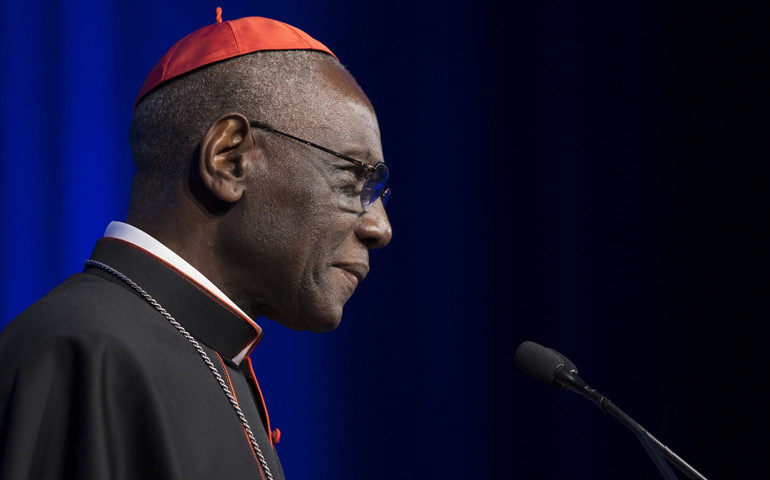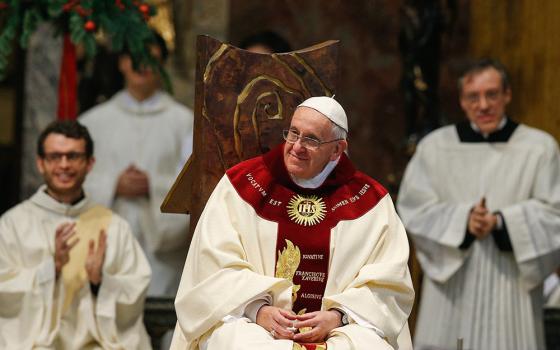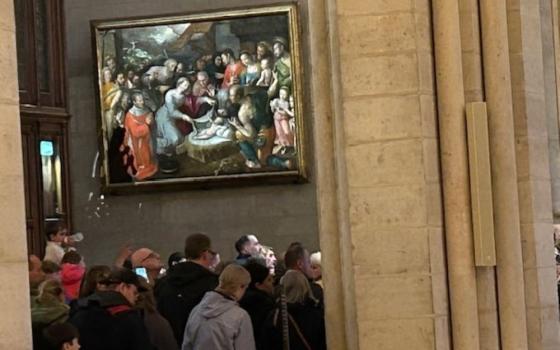
Cardinal Robert Sarah, prefect of the Congregation for Divine Worship and the Sacraments, smiles while speaking at the National Catholic Prayer Breakfast May 17 in Washington. (CNS/Bob Roller)
Pope Francis says he does not like to "cut off heads"; that is, fire people.
And when it comes to facing opposition from the Church's "ultra-conservatives", he says he refuses to engage in conflict.
But it looks like he could be running out of patience with Cardinal Robert Sarah.
And he may now be regretting the peace-making gesture he made in November 2014 (more on that in a moment) when he appointed the African prelate as prefect of the Congregation for Divine Worship and Discipline of the Sacraments.
The pope called the 71-year-old cardinal into his office on July 9 and took him to task for the divisive and controversial remarks on the liturgy that the prefect had made just few days earlier in London.
At a conference attended mainly by enthusiasts of the Tridentine Mass -- before it was reformed in the wake of the Second Vatican Council (1962-1965) -- Sarah said the pope had asked him to form a commission to study the possibility of carrying out a "reform of the reform."
The Guinea native also appealed to all priests around the world to return to the pre-Vatican II custom of celebrating Mass versus orientem (facing East), or what is often called "priest with his back to the people". He suggested they implement this on the first Sunday of Advent (next November 27).
But a statement from the Holy See Press Office on July 11, though written in the classic diplomatic style of the Roman Curia, made it clear that Pope Francis -- like most of the world's bishops -- is opposed to making ad orientem worship normative. And, even more importantly, it indicated that he does not support any such "reform of the [post-Vatican II liturgical] reform", despite Cardinal Sarah's claim.
There is no other way one can read the Vatican communiqué except that the pope corrected the cardinal -- and distanced himself from his views -- in a very clear and public way.
And, in doing so, he has a sent a strong message to the tiny minority of Catholics who continue to push for incorporating parts of the (unreformed) Tridentine Rite into the (reformed) post-Vatican II liturgy. It's not going to happen.
This is a liturgical hot potato that the 79-year-old Francis had sought to avoid. In fact, he appointed Cardinal Sarah to his current job precisely in order to keep the peace with the neo-Tridentinists -- a small, but well-organized, well-funded and extremely vocal group that gained prominence disproportionate to its numbers under Benedict XVI. It has been lukewarm (to say the least!) towards the current pope.
After Pope Francis moved the previous CDW prefect, Cardinal Antonio Cañizares, back to a diocese in Spain, the top post at the worship office remained vacant for nearly three months -- an unprecedented amount of time in that office's history.
Several Vatican sources said the pope had intended to make Archbishop Piero Marini, currently president of the Pontifical Committee for International Eucharist Congresses, the new prefect. The now-74-year-old Italian had been the master of papal ceremonies from 1987-2007. But more importantly, he worked closely with those who helped Paul VI draw up and implement the post-Vatican II liturgical reforms, even serving from 1985-1987 as the CDW undersecretary.
But a group of so-called "Ratzingerians" in the Curia (those more attached to the retired pope's style and vision of the church rather than to his successor's) warned Francis that Marini's appointment would "cause a war." Some say that the former pope himself advised against it.
They feared the archbishop would work to counter some of the controversial and retrograde liturgical changes that Benedict XVI had instituted throughout the church, especially his normalization of the Tridentine Rite through the 2007 motu proprio Summorum Pontificum.
The group then suggested Cardinal Sarah for the post. When John Paul II brought the African prelate to the Vatican in 2001 he was known as pious and doctrinally conservative, but did not seem to be an ideologue thanks to his twenty-two years as Archbishop of Conakry (Guinea).
He spent his first nine years in Rome as the No. 2 official at Propaganda Fide (Congregation for the Evangelization of People). Then Benedict XVI named him president of the Pontifical Council Cor Unum in October 2010 and gave him the red hat one month later. During his time in that office, which was meant to monitor and coordinate Catholic charitable organizations, he emerged more clearly as a cultural warrior who insisted that church social agencies and their employees manifest their Catholic identity clearly and unequivocally.
Cardinal Sarah quickly made a mark as one of the shrillest voices against "gender ideology," same-sex marriage, abortion, contraception and other so-called attacks on the family. During the two autumn Synod sessions on the family (2014 and 2015), and even between those sessions, he was among the most visibly active bishops to warn Pope Francis -- through books, letters and interviews -- not to soften the church's stance on divorce and remarriage.
People continue to scratch their heads in total confusion as to why Francis gave him such a high-profile post in a pontificate in which Sarah seems so out of step. Some believe it was meant to neutralize the cardinal by putting him in charge of an area of church life (the liturgy) that the pope simply takes for granted and about which he is contemplating no further developments.
Others fear he miscalculated the depth of the cardinal's commitment to the neo-Tridentinists and the "reform of the reform" movement.
Up until he caused the stir with his recent talk in London, the pope remained remarkably tolerant with him. But that lecture may have been the final straw.
Because this was not the first time since his appointment as CDW prefect that the cardinal has said controversial things that seem so incongruent with the tone and style Francis has tried to set for his pontificate and the entire church.
The Roman Curia's highest-ranking African official regularly finds time to travel the world as a speaker, often spouting his traditionalist views. At the National Catholic Prayer Breakfast in Washington last May, the Vatican's liturgical chief said there were "insidious signs of war" against religious freedom in the United States.
He went as far as to say the dismantling of "the church's teachings on marriage, sexuality and the human person" through the legalization of such things as same-sex marriage was just as horrible as the "merciless beheadings, futile bombings of churches, torching of orphanages and ruthless expulsions of entire families" that take place in other countries.
If that were not bad enough, Cardinal Sarah has also shown unwillingness to comply with even some of the simplest tasks related to his day job.
In December 2014 the pope instructed him in a formal letter to prepare a document officially changing the rubrics in the Roman Missal for the Holy Thursday feet-washing ritual. This was to allow women to participate in this ceremony.
Months went by.
The cardinal and the Congregation for Divine Worship did nothing.
Finally, the pope stepped in and demanded that the congregation produce a decree to make the necessary changes to the rubrics. It was not published until January 2016 -- over a year after Francis had made his original request.
Questions over Cardinal Sarah's loyalty to the current pope seemed to have been put to rest in October 2014 when -- it is believed at the insistence of the Cardinal Secretary of State -- he abruptly backed out of a scheduled speaking engagement in Rome with an international group of Tridentine Mass enthusiasts. On that same day Cardinal George Pell was also a last-minute "no show" for a liturgy he was due to lead, though an aide delivered his homily.
The date was October 24. One month later Cardinal Sarah was appointed head of the Congregation for Divine Worship.
But a papal appointment that was originally designed to keep peace between factions in the Curia and calm the traditionalist pockets of the Church is now being questioned anew.
Francis has put the cardinal on warning. But if the Congregation for Divine Worship prefect pulls another fast one, don't be surprised if the pope pulls out his axe.
[Robert Mickens is editor-in-chief of Global Pulse. Since 1986, he has lived in Rome, where he studied theology at the Pontifical Gregorian University before working 11 years at Vatican Radio and then another decade as correspondent for The Tablet of London.]
Editor's note: We can send you an email alert every time Robert Mickens' column, A Roman Observer, is posted. Go to this page and follow directions: Email alert sign-up.




